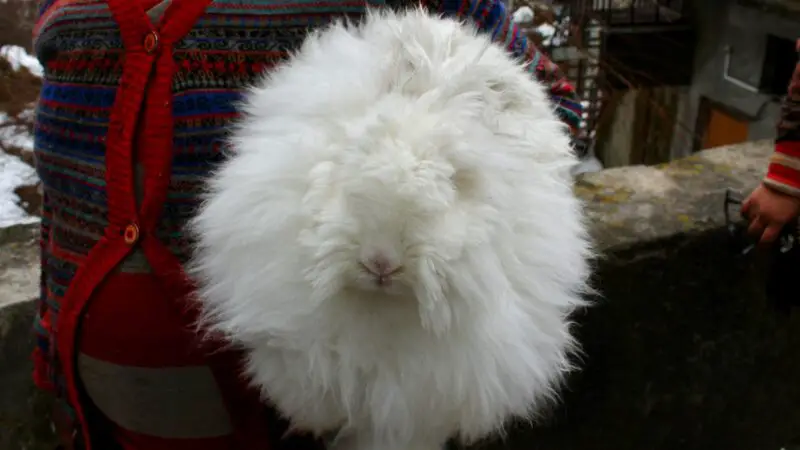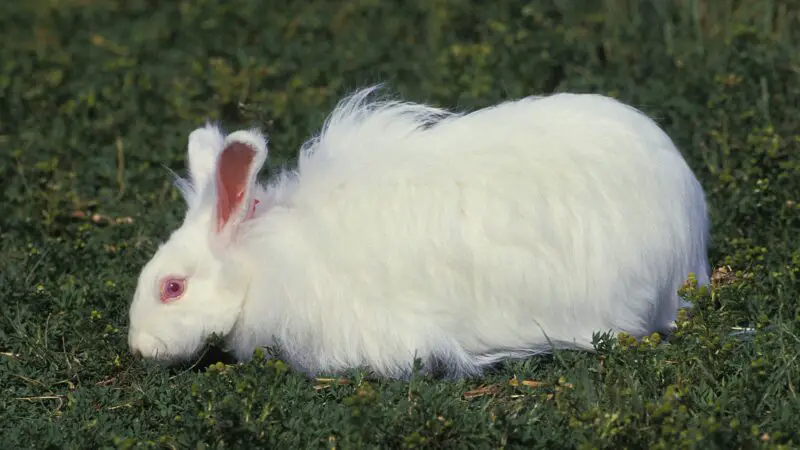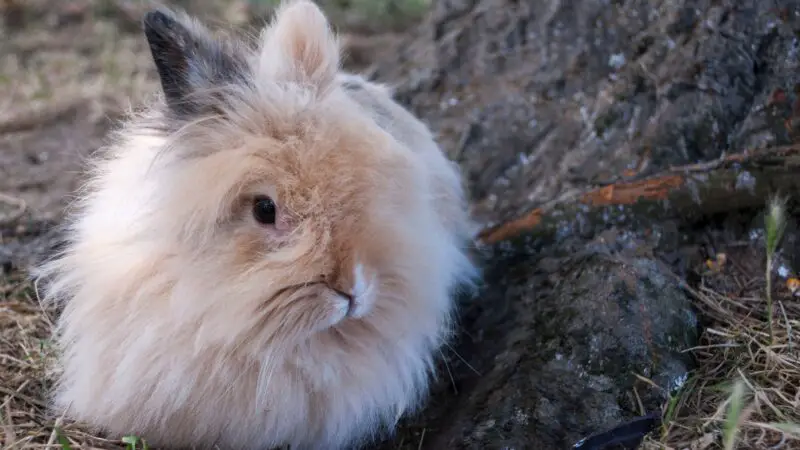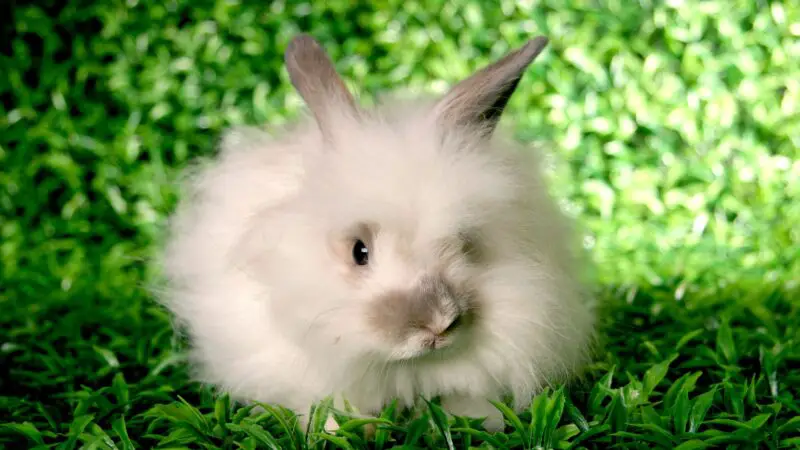If you want to raise rabbits for wool production, the Angora rabbit is the ideal choice. Angora wool is very soft, silky, and much warmer than sheep wool.
As a luxurious fabric, it is the favorite wool for sweaters and other clothing. Not to mention, Angora rabbits are also great pets and companions. Nevertheless, raising them is not as easy as you think.
The German Angora is the best wool producer but is considered endangered. The Giant Angora is the biggest but requires high maintenance. English and French Angoras are both easy to maintain but produce less wool. The wool of Satin Angoras has a high quality but is difficult to spin.
Angora rabbits are very clean animals and love to groom themselves. But unlike cats, rabbits may swallow their fur, which is very dangerous for their health.
So, before deciding to raise them, read this comprehensive guide very carefully. This will also teach you the different types of Angora rabbits and their unique characteristics.
How Do You Identify an Angora Rabbit?
Angora rabbits are generally short and have a round head, medium-sized erect ears, and thin, long legs roofed with feathers. They also have red eyes due to albinism or lack of melanin.
Their bodies are covered with thin, soft, and fluffy wool. Since they have no coloring pigmentation, Angora rabbits are either pure white or white with color patterns.
Do Angora Rabbits Make Good Pets?
Angora rabbits make good pets as long as you groom them regularly. They are very friendly, docile, and smart. These sweet bunnies also play with humans, including small children.
But in general, rabbits don’t like being picked up or cuddled since they easily get frightened. Their spines are also fragile and may easily break if not handled properly.
What Are the Different Types of Angora Rabbits?
There are at least 11 different Angora rabbit breeds, but only four of them are recognized by the American Rabbit Breeders Association (ARBA). They are the Giant Angora, French Angora, English Angora, and Satin Angora. The German Angora is recognized by the International Association of German Angora Rabbit Breeders (IAGARB).
1. Giant Angora

Place of Origin
The Giant Angora originated in Taunton, Massachusetts, and is the only Angora rabbit breed that was created in the US. This American Angora rabbit was developed by Evergreen Farm founder Louise Walsh by crossing Flemish Giants, French Lops, and German Angoras. The Giant Angora rabbit breed was recognized by the ARBA in 1988.
Appearance
The Giant Angora is the largest among the four rabbit breeds recognized by the ARBA. This impressive rabbit breed has a huge, oval head, a wide forehead, a slightly narrow muzzle, and large, erected ears.
Their faces and ears have noticeable furnishings. They are sometimes mistaken for German Angoras but are a different rabbit breed.
Interestingly, Giant Angoras possess three types of wool – soft under wool, awn fluff, and awn hair. The underwool is the most dominant, while the awn fluff is strongly crimped with a hook end and can be found between the underwool and the awn hair. Also called guard hairs, awn hairs are straight, long, and extend beyond the other fibers.
Height
There are no records showing the height of Giant Angoras. But because of their gigantic size, they are expected to be the tallest of them all.
Weight
The Giant Angora weighs about 9 1/2-10 lbs (4.3-4.5 kilos) or more and is the heaviest Angora rabbit breed. In fact, it is the only rabbit breed that belongs to the 6-class rabbit category.
In this class, a senior buck (adult male rabbit) should weigh at least 9 1/2 pounds, and a senior doe (adult female rabbit) should weigh at least 10 pounds.
Color
The Giant Angora comes in black and white varieties. But then, the White Giant Angora is the only color accepted by the ARBA. The black variant is still under development.
Giant Angoras are also referred to as Ruby-eyed White rabbits since their eyes are ruby red. They are also called albino rabbits due to the absence of melanin pigmentation.
Characteristics
Giant Angora rabbits are very friendly, docile, and gentle. They also don’t easily startle and make great pets, even for small children.
Being huge and active, these gentle giants prefer being outdoors rather than in their hutch or cage. However, these bunnies partially molt (or don’t molt at all), so you should regularly harvest their wool by hand shearing.
Lifespan
When properly cared for, the Giant Angora can have a lifespan of 7 to 12 years.
Purpose
Giant Angoras are a dual-purpose breed, but their main purpose is for producing wool. These fiber mammals are excellent producers of wool.
They can also be sold for meat and are decent for dinner. Rabbit meat tastes like chicken but is a bit stronger. But since rabbits are naturally friendly, you might want to keep them as pets instead of eating them.
2. German Angora

Place of Origin
As the name implies, the German Angora originated in Germany. It was developed sometime in 1777 but arrived in the US only in the 1960s.
German Angoras are now considered endangered and are not recognized by the ARBA. The current standard is maintained by the International Association of German Angora Rabbit Breeders (IAGARB).
Appearance
The German Angora looks like Giant Angoras, except that they are smaller. They also have the same types of wool fiber – underwool, awn fluff, and awn hair.
According to the IAGARB, a standard German Angora should have a tubular, deep, medium-length body and is as wide as its shoulders. The body length should also be three times its width.
German Angoras in the US are mutations of the European wild rabbit (Oryctolagus cuniculus) and also resemble English Angoras. They have dense, silky wool all over their bodies instead of cottony.
This Angora breed also has short necks, medium-length but strong hind legs, and tassels (short threads of wool) at the end of their ears.
Height
There is no standard height for German Angoras, except that it should be the same as their body width.
Weight
According to the IAGARB standards, the German Angora should have a weight range of 2.5-5.0 kilos (approx. 5.5-11 lbs). The average weight is 3.5 kg (around 7.7 lbs).
Color
The most common color of German Angoras is white. They are also referred to as albino rabbits.
Other accepted color varieties include black, blue (diluted black), chocolate brown, and lilac (diluted brown). Color groups that are also accepted are Agouti, Chinchilla, and Tortoiseshell. There are no bi-colored German Angora rabbits, though.
Characteristics
German Angora rabbits are gentle, calm, and extremely friendly. Small children can play with them and carry them gently.
As loving pets, they are also very sociable and can do well indoors and outdoors. Unlike Giant Angoras, German Angoras molt since their fur is remarkably resistant to matting. Grooming is not necessary, but you have to clip them.
Lifespan
Generally speaking, the German Angora can live between 7 and 12 years.
Purpose
The main purpose of German Angoras is wool production. They can produce a whopping 2 1/2-4 1/2 lbs (approx 1.1-2 kilos) of wool per year.
They set a world record of 2,232 grams (around 5 lbs) in 1990 and 2,800 grams (around 6.2 lbs) in 2000. You also raise German Angoras for meat, but they were originally bred for producing wool.
3. French Angora

Place of Origin
As the name suggests, the French Angora originated in France, being the first country in Europe where Angora rabbits are raised for their wool. It is believed that French sailors brought them to the country from Ankara (now Angora), Turkey sometime in 1723. Hence, this rabbit breed is closely related to the generic “angora” from Europe.
Appearance
Unlike German Angoras and Giant Angoras, French Angoras have hairless faces and front feet. The head is oval and is also hairless.
Some strains have small ear tufts, but most of them have none, which many breeders prefer. Their hind legs also have some small tufts. As per standard, their bodies should be oblong when viewed from above.
French Angoras are also known for having straight, long, and abundant guard hairs that protect their soft underwool. Their coat is less prone to matting, as compared to other Angoras. This makes them very easy to groom and requires less maintenance. On the other hand, their texture is smooth and silky, which makes spinning a bit challenging.
Height
There are no records of the average height of French Angoras. But since they are the second biggest Angora breed, these bunnies are expected to be tall.
Weight
The adult French Angora weighs about 7.5-10.5 lbs (3.4-4.8 kilos), and the ideal weight is 8.5 lbs (3.8 kilos). The younger ones can weigh between 3.75 and 7.50 lbs (1.7 and 3.40 kilos).
Color
The color of French Angoras is based on the color of the head, feet, and tail, all of which have the same color. They can be a ruby-eyed white, solid color, or broken varieties, which is white with a combination of other recognizable colors. This includes black, blue, brown (chocolate), and lilac. The toes should also be of the same color as their bodies.
Characteristics
The French Angora is friendly, docile, and has a very gentle disposition. They enjoy the company of humans, including small children.
Although they have no problems with being confined, these fluffy mammals enjoy more when they are outside. French Angoras molt naturally every few months, which means that regular grooming is necessary.
Lifespan
If they are well cared for, French Angoras can live between 7 and 12 years.
Purpose
The French Angora is a dual-purpose rabbit breed. In fact, it is highly commercial in terms of wool and meat. Their fiber is ideal for making baby clothes, mittens, and sweaters.
On the other hand, their meat tastes no different from other rabbit breeds. They also somehow taste like chicken. But again, this wooly mammal is great as a pet.
4. English Angora

Place of Origin
English Angora rabbits came from French Angoras in 1939. This was when the ARBA decided to re-classify the Angora Wooler, which was the only registered rabbit breed at that time.
The ARBA officially separated the English Angoras from the French Angoras in 1944. Hence, these two breeds are not the same and are different from each other.
Appearance
English Angoras are a unique breed of Angora rabbits. They are the only ones with abundant facial hairs that cover their eyes.
These cute bunnies have dense fur all over their compact bodies, with thick, long guard hairs that cover their crimped underwool. They also have a broad, flat head, as well as short, close V-shaped ears with tassels.
The wool of the English Angora is healthy, fall-free, and should have a silky texture. It is also concentrated at the back and looks like a flat pancake when viewed from above.
Their feet are also covered with wool. Once properly posed, the English Angora looks like a round ball of fluff. They have fragile backs, making them not fit for small children.
Height
No records are revealing the height of English Angoras. But because of their small size, they are expected to be the shortest of them all.
Weight
Adult male English Angoras weigh between 5 and 7 lbs (2.3 and 3.2 kilos), with an ideal weight of 6 lbs. Adult females between 5 and 7 1/2 lbs (2.3 and 3.4 kilos), with an ideal weight of 6 1/2 lbs.
Meanwhile, young males weigh between 2.75 and 5.5 lbs (1.3 and 2.5 kilos), and young females weigh between 2.75 and 6.0 lbs (1.3 and 2.7 kilos).
Color
The English Angora comes in two major color classifications – white and broken colors. The only color varieties that the ARBA recognizes are Agouti, Broken, Pointed White, Ruby-eyed White, Self, and Shaded. Nonetheless, English Angoras are also available in other colors, including Blue, Chinchilla, Chocolate, Golden, Lilac, Sable, and Smoke.
Characteristics
English Angoras are calm, docile, and very sociable. These pleasant rabbits are also smart and can easily be taught basic tricks and toilet training.
Although they are also friendly to small children, these very hairy pets molt. Their wool should be harvested by shearing or plucking. Otherwise, they can get sick once wool builds up in their stomach.
Lifespan
The English Angora has a lifespan of between 7 and 12 years.
Purpose
Despite being the smallest, the English Angora can be bred for wool production. They can produce about 12 – 16 oz (340 – 453 grams) of wool a year. But because of their Teddy bear-look face furnishings, English Angoras are mostly bred as a show breed.
5. Satin Angora

Place of Origin
The current Satin Angora originated in Ontario, Canada during the late 1970s. It was developed by Leopoldina Meyer, who crossed her Satin rabbits with French Angoras.
The original Satin Angora was developed in the 1930s by American rabbit pioneer John C. Fehr. However, he stopped his project because he thought it had no commercial value.
Appearance
The Satin Angora has no furnishings on its face, ears, or feet. Like the Satin rabbits, they also have glossy sheen wool, which other Angora rabbit breeds don’t have.
The satin look is due to the recessive ss genotype, which causes the diameter of the casing around each hair shaft to be narrow and translucent, and intensifies the pigmentation.
Satin Angoras have the softest, silkiest, and finest wool among all the Angora rabbits. They are also the least wool-producing Angora rabbit of all.
The Satin Angora also has an oval head, a broad forehead, and a narrow muzzle. Their bodies are of medium length with slightly tapered sides, and their erected ears are plain or vaguely tufted.
Height
Despite having no records about their height, Satin Angoras are expected to be quite short.
Weight
Adult Satin Angoras weigh between 6.5 and 9.5 lbs (2.9 and 4.3 kilos), with an average weight of 8 lbs (3.6 kilos). On the other hand, the younger ones weigh between 3.75 and 6.5 lbs (1.7 and 2.9 kilos).
Color
Satin Angoras come in two major color groups – the white group and the colored pattern group. The white group consists of Blue-Eyed White, Pointed White, and Red-Eyed White.
Meanwhile, the colored pattern group consists of the Broken, Colored, Self, Shaded, Tortoiseshell, Ticked Color, and Wide Band Color.
Characteristics
Satin Angoras are friendly, curious, and very playful rabbits. They enjoy socializing with humans, love to play with toys, and prefer hopping outside instead of being confined in a small area.
These bunnies are friendly, very affectionate, and less difficult to groom than French Angoras. However, their strong wool is more challenging to spin.
Lifespan
Just like other Angora breeds, Satin Angoras have a lifespan of 7 and 12 years.
Purpose
Satin Angoras are mainly raised for fur production. In fact, they are the most favorable Angora rabbit when it comes to wool. Their wool is known for being useful in making clothes and blankets.
But then, the Satin Angora also makes an ideal pet. And although they can also be bred for meat, these rabbits are better alive than on the dinner table.
How Much Are Angora Rabbits?
The cost of Angora rabbits depends on age, breed, gender, quality, and location (or shipping fee). As of June 2022, a young Angora rabbit can cost between $75 and $240.
How to Raise Angora Rabbits?
Angora rabbits are not expensive to breed since they don’t eat too much, and breeding is quite fast. Harvesting wool is a relaxing activity not only for the rabbit but also for the owner.
In general, rabbits get sick when wet, and you should not bathe them. This can also save you time. Nonetheless, here are some tips on how to raise Angora rabbits:
- Know your purpose. Although Angora rabbits are mostly for wool production, they can also be bred for meat or simply keep them as pets.
- Choose the right Angora rabbit for you. Some of them are easier to maintain than others but are not so productive in terms of wool.
- If you want to raise Angora rabbits for profit, study first how to market wool. Angora wool is very expensive, but the market is not that big.
- Prepare the housing (hutch) for your rabbits. The cage size depends on the natural behavior and weight of your rabbit. The rule of thumb is 7.5 square feet per rabbit, not including the space for food and water. The height should be at least 9 inches. Avoid mixing two rabbits in the same cage. Otherwise, they may fight each other.
- Provide nest boxes before the doe gives birth. A rabbit litter size is 2-15. For German Angoras, the recommended size for each nest box is 18 x 12 x 8 inches.
- Provide them with a balanced diet of hay and grain, as well as clean drinking water. Note, however, that hay contains dust that can contaminate wool. You can also feed them with fresh, leafy vegetables and commercial feed.
- Clean their cages regularly, and make sure they are always dry.
- Rabbits are very sensitive to extreme temperatures, which means they require proper ventilation and shade at all times.
- Rabbits are prone to parasites and diseases, especially when it comes to their respiratory system. Monitor their behavior regularly, and keep records of their health status.
- Protect them from predators by installing high fences in their outside housing.
- Shearing Angora rabbits are the most crucial part and are very time-consuming. Make sure you have enough time to trim them.
How to Shave an Angora Rabbit?
To start with, shaving an Angora rabbit is not the same as shaving a human’s head or beard. Unlike humans, rabbits have sensitive skin that can be damaged once exposed to the sun for a long time.
Although the term “shaving” is sometimes used when cutting a rabbit’s fur, the more appropriate word to use is “shearing”, “trimming” or “clipping.”
Shearing or clipping an Angora rabbit is more than just cutting its fur to sell them. It also makes your pet healthy and happy. Once a rabbit grooms itself, it may ingest wool, which can cause a “wool block” in its digestive system. In effect, the poor animal will die in a few days.
To help you, here are the steps on how to shear an Angora rabbit properly:
Step 1: When shearing a rabbit, you can use hairdressing scissors or an electric clipper such as Aesculap FAV5 Corded Clipper. Electric clippers can do the job faster than scissors, but the buzzing sound can scare your rabbit.
Step 2: Before shearing, you should first groom your pet. Here, you will need a towel, a wide-toothed comb, a slicker brush, and a high-speed blower. Better yet, use a Pet Hair Dryer with Slicker Brush.
- 【Dryer and Slicker Brush in One】The 2 in 1 pet grooming dryer...
- 【Two Temperature Settings】 High and low level temperature can...
- 【Safe for Pet】 The stainless steel pins have the safety tips,...
- 【Lightweight&Portable】 The pet grooming dry with compact...
- 【Perfect Gift】 This new upgraded pet hair dryer with less...
Step 3: Place the towel on a table or your lap, and comfortably position your rabbit.
Step 4: Groom your pet to remove debris from its coat and align the wool. Don’t forget the head and ears, but be careful around their eyes.
Step 5: For proper shearing, start with the top coat and the thickest part of the fur. Make sure that your rabbit is dry. Note that wet bunnies can easily get sick.
Step 6: Collect the cut wool in a container. Don’t worry if your trimming is not even, as you can repeat the process until it becomes neat. If your rabbit feels uncomfortable, rest for a while.
Step 7: Once the top coat is done, turn your Angora rabbit over to start shearing its underside. To keep your pet firm and steady, you can place it gently between your knees. Place the cut underside wool in a separate container.
Step 8: Once shearing is finished, brush your rabbit again to make sure that all cut fur is removed. Before bringing your pet back to its hutch, add some bedding so it will feel warmer.
How to Remove Matted Fur From an Angora Rabbit?
Matted fur means that the fur is densely tangled. It usually occurs in rabbits with thick and long hair. In some cases, you can brush it off carefully.
For stubborn mats, cut the tips first and try untangling them with your hand or use a mat splitter for rabbits. Be careful with mats that are very close to the skin. If necessary, consult your nearest veterinarian.
- BEST MATS AND TANGLES REMOVER! - The dual sided 12+23 teeth...
- SAFE & PLEASANT! - The dematting tool's blades are very sharp on...
- GREAT VALUE & 100% SATISFACTION! – Just contact us if you have...
- HELP SAVE OTHER ANIMALS! - When you buy any product from the Pet...
- HIGH QUALITY! - Our stainless steel teeth are strong and sharp to...
How Often Do You Shear Angora Rabbits?
The frequency of shearing Angora rabbits depends on the breed and how fast their fur grows. Ideally, you should trim rabbit wool once they are at least 3 inches long, which starts when the animal is 1-3 months old.
But more importantly, you should trim your rabbit’s fur during the molting period. Again, rabbits may eat wool and will eventually die.
How Long Do Angora Rabbits Live?
All Angora rabbits can live between 7 and 12 years.
What Does the Angora Rabbit Eat?
Like other rabbit breeds, Angora rabbits are herbivores. But contrary to popular myth, their favorite food is not carrots.
In fact, you should not feed them regularly with root vegetables because they contain a huge amount of sugar. Instead, feed them with grains, hay, grass, and green leafy vegetables such as cabbage, clover, and spinach.
Where Are Angora Rabbits Found?
Angora rabbits can be found all over the world. Nevertheless, they are more common in Argentina, Brazil, Chile, China, France, Germany, Hungary, India, Korea, and the US.
Ironically, Angoras are quite rare in their country of origin, Turkey. So far, China has the most Angora rabbits and produces around 90% of Angora wool worldwide.
List of Sources
Angora Rabbit Fiber Production in the World and Turkey
Acclimatization of Angora Rabbits in Warm Climate and Its Impact on National Economy



